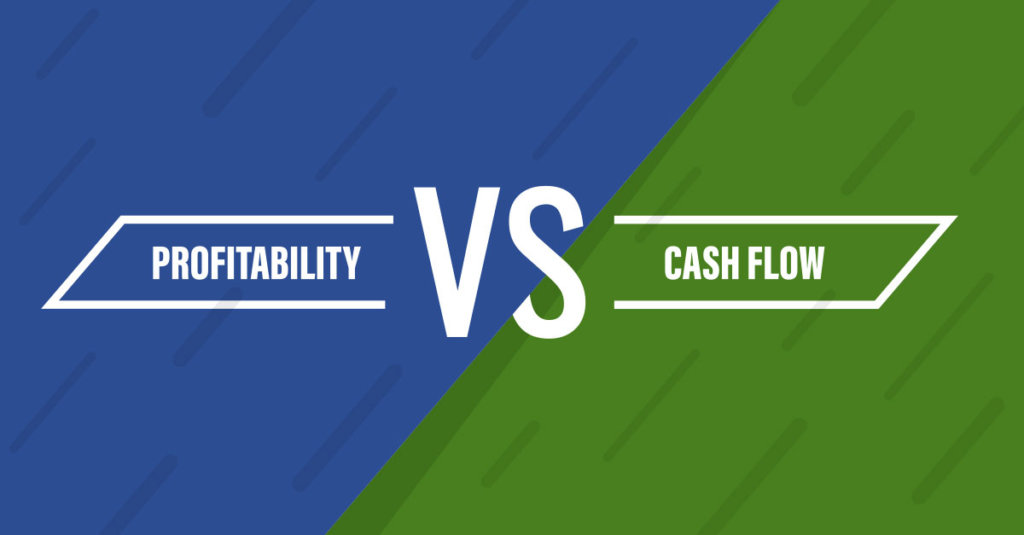
Profitability and cash flow are two important business concepts that can be confused by many small business owners. Just because a business is profitable, doesn’t necessarily mean it cash flows. Alternatively, a business can have positive cash flows and not be profitable. These are topics that are often difficult to understand, so let’s dig into how these statements are possible. First off, let’s take a deeper look at profitability and cash flow.
What is Profitability?
Profitability is the ability of a business to earn a profit — meaning business revenues exceed business expenses. The income statement is used to analyze business profitability. This seems simple and straightforward, but one needs to remember that not all checkbook debits are business expenses. One common example of this is loan payments, specifically principal payments on loans, which are not business expenses. Remember, a loan payment is comprised of two components – principal and interest. Interest paid on business loans qualifies as a business expense. Principal payments do not. Principal payments made on loans impact the balance sheet and statement of cash flows but do not impact the income statement. What replaces principal payments on term loans as deductions on the income statement? Depreciation. Depreciation is a deductible expense on the income statement. But depending on tax management strategies, these two items may not align. If “fast depreciation” strategies are used for tax management — like Section 179 expensing and Bonus Depreciation — and loans are taken out to finance capital purchases; principal payments may be a cash flow detriment beyond the depreciation expense.
What is Cash Flow?
Cash flow is cash utilization by the business or the flow of money through the operation. The cash flow statement measures how well a business manages its cash. Can it generate enough cash to pay back debt and fund operations? Cash flow encompasses the flow of money to three places for business activities – operating, investing, and financing. Therefore, all sources and uses of cash are taken into account when considering cash flow — including income, expenses, capital purchases, capital sales, money borrowed, and loan payments.
How can a business be profitable and not cash flow?
Back to the original questions, “Can a business be profitable and not cash flow?” and “Can a business have positive cash flow and not be profitable?” The answer to both is yes. Money borrowed has a positive impact on cash flow but does not provide profitability. Also, a business strapped with large loan payments may turn a profit, but not provide enough cash for loan payments. Additionally, owner withdrawals or family living expenses in excess of profits would be a detriment to cash and another opportunity for a business to show profits and not cash flow. The timing of cash is also important. On a day-to-day basis, a business may not have adequate cash available, but over time have adequate profits. A classic example of this would be a grain operation. There is typically a large portion of the year with little income or cash inflows, but expenses are incurred. Cash is needed to pay expenses to put the crop in the ground months before any cash revenue from grain sales is available. If a farm doesn’t have adequate cash going into the year, an operating loan will be needed to get to the end of the year when grain is sold and profits are turned.
FINPACK’s credit analysis tools can assist with analyzing business profitability and cash flow. In fact, many of our tools analyze both. For agricultural credit analysis, Schedule F Cash to Accrual, Financial Analysis (FINAN), and Projections all analyze both profitability and cash flow. For commercial credit analysis, the C & I Business Analysis analyzes profitability and has cash cycle analysis included. The Commercial Real Estate Analysis measures the profitability of commercial properties. And commercial credit analysis has an Annual Cash Flow Plan tool as well. Both commercial and agricultural credit analysis components offer a Global Cash Flow Analysis tool as well.
Summary
Helping business customers understand profitability versus cash flow is key to business management. Profitability does not necessarily equal positive cash flow. Alternatively, positive cash flow does not necessarily mean the business is profitable. To be financially successful over time, profitability should provide enough funds for the investing and financing needs of the business.
Connect with FINPACK
Don’t forget to follow FINPACK on Facebook, Twitter, and Instagram, or connect with us on LinkedIn, and be sure to subscribe to FINPACK News email updates.
Pauline Van Nurden joined the FINPACK Team as an Economist in 2017.
Prior to joining the FINPACK Team, she worked as a lender. This provides her valuable industry experience and knowledge in her work with FINPACK. Pauline holds a Master’s Degree in Agricultural Education and Bachelor’s Degree in Applied Economics, both from the University of Minnesota.





